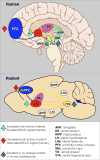Impact of Sleep and Circadian Rhythms on Addiction Vulnerability in Adolescents
- PMID: 29373120
- PMCID: PMC5972052
- DOI: 10.1016/j.biopsych.2017.11.035
Impact of Sleep and Circadian Rhythms on Addiction Vulnerability in Adolescents
Abstract
Sleep homeostasis and circadian function are important maintaining factors for optimal health and well-being. Conversely, sleep and circadian disruptions are implicated in a variety of adverse health outcomes, including substance use disorders. These risks are particularly salient during adolescence. Adolescents require 8 to 10 hours of sleep per night, although few consistently achieve these durations. A mismatch between developmental changes and social/environmental demands contributes to inadequate sleep. Homeostatic sleep drive takes longer to build, circadian rhythms naturally become delayed, and sensitivity to the phase-shifting effects of light increases, all of which lead to an evening preference (i.e., chronotype) during adolescence. In addition, school start times are often earlier in adolescence and the use of electronic devices at night increases, leading to disrupted sleep and circadian misalignment (i.e., social jet lag). Social factors (e.g., peer influence) and school demands further impact sleep and circadian rhythms. To cope with sleepiness, many teens regularly consume highly caffeinated energy drinks and other stimulants, creating further disruptions in sleep. Chronic sleep loss and circadian misalignment enhance developmental tendencies toward increased reward sensitivity and impulsivity, increasing the likelihood of engaging in risky behaviors and exacerbating the vulnerability to substance use and substance use disorders. We review the neurobiology of brain reward systems and the impact of sleep and circadian rhythms changes on addiction vulnerability in adolescence and suggest areas that warrant additional research.
Keywords: Addiction; Adolescence; Circadian; Circuitry; Reward; Sleep.
Copyright © 2017 Society of Biological Psychiatry. Published by Elsevier Inc. All rights reserved.
Conflict of interest statement
All other report no biomedical financial interests or potential conflicts of interest.
Figures



Comment in
-
Alterations of the Biological Clock May Contribute to the Emergence of Mental Disorders During Adolescence.Biol Psychiatry. 2018 Jun 15;83(12):978-980. doi: 10.1016/j.biopsych.2018.04.004. Biol Psychiatry. 2018. PMID: 29804587 No abstract available.
References
-
- Sharma A, Morrow JD. Neurobiology of Adolescent Substance Use Disorders. Child Adolesc Psychiatr Clin N Am. 2016;25:367–375. - PubMed
-
- Kandel DB, Johnson JG, Bird HR, Canino G, Goodman SH, Lahey BB, et al. Psychiatric disorders associated with substance use among children and adolescents: findings from the Methods for the Epidemiology of Child and Adolescent Mental Disorders (MECA) Study. J Abnorm Child Psychol. 1997;25:121–132. - PubMed
-
- O'Neil KA, Conner BT, Kendall PC. Internalizing disorders and substance use disorders in youth: comorbidity, risk, temporal order, and implications for intervention. Clin Psychol Rev. 2011;31:104–112. - PubMed
Publication types
MeSH terms
Grants and funding
- R21 DA041872/DA/NIDA NIH HHS/United States
- K02 DA042886/DA/NIDA NIH HHS/United States
- R01 MH077159/MH/NIMH NIH HHS/United States
- R01 MH106460/MH/NIMH NIH HHS/United States
- R01 DA042029/DA/NIDA NIH HHS/United States
- R21 DA041563/DA/NIDA NIH HHS/United States
- R33 DA041872/DA/NIDA NIH HHS/United States
- K01 MH077106/MH/NIMH NIH HHS/United States
- K01 DA038654/DA/NIDA NIH HHS/United States
- R01 DA033064/DA/NIDA NIH HHS/United States
- P50 DA046346/DA/NIDA NIH HHS/United States
- P50 DA039841/DA/NIDA NIH HHS/United States
- R01 MH104418/MH/NIMH NIH HHS/United States
- R01 DA035805/DA/NIDA NIH HHS/United States
- K01 DA032557/DA/NIDA NIH HHS/United States
- R01 MH101147/MH/NIMH NIH HHS/United States
- R21 AA025547/AA/NIAAA NIH HHS/United States
- R01 DA039865/DA/NIDA NIH HHS/United States
- R01 AG047139/AG/NIA NIH HHS/United States
- UH3 HL125103/HL/NHLBI NIH HHS/United States
- UH2 HL125103/HL/NHLBI NIH HHS/United States
LinkOut - more resources
Full Text Sources
Other Literature Sources
Medical

